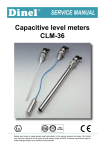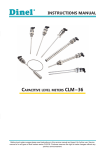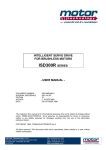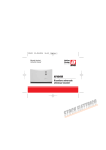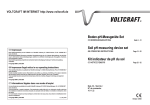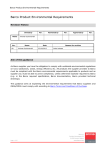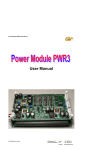Download SERVICE MANUAL
Transcript
SERVICE MANUAL CAPACITIVE LEVEL METERS CLM – 36 Before level meters usage please read instructions in this service manual and keep it for further use. Service manual is for all types of level meters series CLM-36. Producer reserves the right to make changes without any previous announcement. Content Content ..................................................................................................................................2 I. Description..................................................................................................................3 II. Technical specification............................................................................................ 4-7 Types and performance of electrode...........................................................................8 III. Linearity.......................................................................................................................9 IV. V. Mounting and dismounting.................................................................................. 10-12 Instalation of level meter and placing in operation....................................................13 VI. VII. Preparing of level meter for measuring.....................................................................14 VIII. Setting of level meter with unknown value of permittivity of measured medium.......15 Setting of level meter with known value of permittivity of measured medium..... 16-18 IX. X. Maintainance and service of level meter...................................................................19 Protection, safety, compatibility and explosion proof................................................20 XI. XII. Marking of level meters.............................................................................................21 XIII. Marking of labels................................................................................................. 22-23 XIV. Accessories...............................................................................................................24 XV. Table of relative permittivity (dielectric constants) of selected materials............. 25-26 . . -2- I. Description Capacitive level meters CLM-36 are designed for continuous level measurement of liquids, powders and bulk-solid materials in vessels, tanks, sumps, containers, silos, etc. Variants according working areas: - for non-explosive area: CLM-36N_-_ _-_ - for explosive area: CLM-36Xi_-_ _-_ Available is high temperature performance for both working areas: - high temperature performance for non-explosive area: CLM-36NT-_ _-_ - high temperature performance for explosive area: CLM-36XiT-_ _-_ Classification of areas: Performance of level meter Part of the level meter with electrode Part of the level meter with housing CLM-36N non-explosive CLM-36NT non-explosive 1) II 1 GD T 83°C EX ia IIB T5 with ISIR CML-36Xi zone 0, zone 20 1) CLM-36XiT II 1/2 GD T 83°C EX ia IIB T5 with ISIR zone 0, zone 20 zone 1, zone 21 The electrode and its surroundings (the wall of vasel, the reference tube, etc.) make capacitor. The electrode is designed according measured material: - variant with rod electrode: - variant with rod electrode and reference tube: - variant with rope electrode: CLM-36_ _-10, 12 CLM-36_ _-20, 22 CLM-36_ _-30, 31, 32 Available is mechanical connection: - with thread: - without thread: CLM-36_ _-_ _-MM36x2 CLM-36_ _-_ _-GG1" CLM-36_ _-_ _-Cl Triclamp Inside of the level meter´s housing is placed removable electronic module with adjustment elements (see chapter VII). 1) ISIR - Intrinsically safe isolating repeater (example IRU-420) -3- II. Technical specification Type of level meter CLM-36__-__-_ Supply voltage: - var. N, NT - var. Xi, XiT 9 ÷ 36 V DC 9 ÷ 30 V DC Current output: - non-activated electrode - full-activated electrode Max. internal values of Xi version Sensitivity ranges Maximum capacity of flooded electrode (range) 4 mA 20 mA Ui=30VDC, Ii=132mA, Pi=0,99W, Ci=370nF, Li=0,9mH 20, 30, 50, 100, 150, 300, 500, 1000 pF 70, 250, 600, 1200, 3000, 7000, 18000, 36000 pF Initial capacity regulation ratio min. 1:2 Nonlinearity max. 1 % Temperature error max. 0,05% / K Voltage error max. 0,3 μA / V Internal resistance / electric strength (electrode - housing) Coupling capacity / electric strength (housing - supply leads) Allowed temperature range in zone 0 (EN 50284) 1 MΩ / 250 V AC var. N var. Xi 51 nF / 250 V AC 26 nF / 500 V AC -20 to +60°C Allowed pressure range in zone 0 (EN 50284) 0,8 to 1,1 bar (0,08 to 0,11 MPa) Protection class: - housing - connector type GDM 2009 - connecor type GDM-K 2000 IP 67 IP 65 IP 67 Connector socket type Hirschmann DIN 43 650 GDM 2009 (standard) GDM-K 2000 (optional) Recommended cable Max. load (serial) resistance (U = 24 V) Weight of the housing (without electrode) -4- 2 x 0,75 mm2 Rmax=750 Ω var. N, Xi aprox. 0,5 kg var. NT, XiT aprox. 1 kg II. Technical specification Temperature resistance of CLM-36N(NT,Xi,XiT): Variant of performance Temperature of medium (at electrode) Ambient temperature range ta (at housing) variant N variant Xi CLM-36_ _-10, 20-_ -40 to +200°C -40 to +85°C -40 to +75°C CLM-36_ _-12, 22-_ -40 to +120°C -40 to +85°C -40 to +75°C CLM-36_ _-30, 31, 32-_ -40 to +105°C -40 to +85°C -40 to +75°C Pressure resistance of performance CLM-36N(Xi): Variant of performance Maximum operating overpressure for ta = -40 to +20°C for ta = -40 to +85°C CLM-36_-10, 20-_ 3 MPa 1 MPa CLM-36_-12, 22-_ 3 MPa 1 MPa CLM-36_-30, 31, 32-_ 1 MPa 0,5 MPa Pressure resistance of high temperature performance CLM-36NT(XiT): Temperature in connection point Maximum overpressure + 100°C +120°C +150°C +180°C 3,0 MPa 2,0 MPa 1,5 MPa 0,5 MPa Used materials: Part of the level meter (type) Material standard optional PTFE st. steel W. Nr. 1.4571, Incoloy 825 (W. Nr. 2.4858) - electrode (10, 12, 20, 22) st. steel W. Nr. 1.4301 st. steel W. Nr. 1.4571 electrode (30, 31, 32) zinc coated steel rope - housing (all) insulation bushing (all) electrode coating (12, 22, 32) electrode coating (30, 31) weight insulation (32) st. steel W. Nr. 1.4301 FEP - polyolefin (modified PE) PTFE PTFE - weight / anchor mechanism (30, 31, 32) st. steel W. Nr. 1.4301 - reference tube (20, 22) st. steel W. Nr. 1.4306 st. steel W. Nr. 1.4571 -5- II. Technical specification Dimensions of each variants: with rope electrode: CLM-36_ _-10-_ CLM-36_ _-12-_ CLM-36_ _-20-_ CLM-36_ _-22-_ CLM-36_ _-30-_ CLM-36_ _-_ _-M CLM-36_ _-_ _-G E1000 ... E20000 reference tube housing withTriclamp coupling weight housing with thread: rope electrode with rod electrode and reference tube: rod electrode with rod electrode: CLM-36_ _-_ _-Cl Z* - var. M - thread M-36x2 - var. G - thread G1“ -6- II. Technical specification Dimensions of each variants: with rope electrode: with rope electrode with anchor: high temperature performance: CLM-36_ _-32-_ CLM-36_ _-31-_ CLM-36_T-_ _-_ high temperature adapter anchor with spherical joint anchor rod housing with electronic module weight rope electrode outlet nut connector steel anchor bushing or dusttight bushing housing and type of electrode according specific version wall of container pushing spring -7- III. Types and performance of electrodes Characteristic of variants: CLM-36_ _-10-_ With uncoated rod electrode - for level measurement of non-conductive liquids (oils, diesel, benzine) and bulk-solid materials (flour, sand, cement, plastic granulates, etc.). Max. electrode length 5 m. CLM-36_ _-12-_ With coated rod electrode (FEP isolating) - for level measurement of water and other conductive liquids including waste liquids in metal vessels, concrete sumps, reservoirs, etc. Resistant against aggressive medium, lower adhesion to some mediums. Max. electrode length 3 m. CLM-36_ _-20-_ With uncoated rod electrode and reference tube - for level measurement of clean nonconductive liquids (oils, diesel, benzine). By means of reference tube the output signal does not depend on the dimension and shape of the vessel. Impossible to use for waste and high viscosity liquids and bulk-solid materials. Max. electrode length 3 m. CLM-36_ _-22-_ With coated rod electrode (FEP isolating) and reference tube - for level measurement of clean conductive liquids. Main use is for measurement in plastic and glass vessels and for fine measuring. Not suitable for waste water and high viscosity liquids and bulk-solid materials. Max. electrode length 3 m. CLM-36_ _-30-_ With coated rope electrode (polyolefine isolating) and uncoated weight - for level measurement of bulk-solid materials (grains, sand, flour, cement, etc.). Max. electrode length 20 m. CLM-36_ _-31-_ With coated rope electrode with anchor (polyolefine isolation) and uncoated weight - as the type 30. For use for higher silos. Max. electrode length 20 m. CLM-36_ _-32-_ With coated rope electrode (FEP isolation) and coated weight (isolation PTFE) - for level measurement of conductive and non-conductive liquids. Max. electrode length 20 m. -8- IV. Linearity Influence of the tank shape on a linearity of measured capacity of nonconductive liquids: 1. In the tank with straight wall (for example vertical cylinder) and with the sensor placed parallely with the wall capacity change is linear. 2. In a curved tanks (most frequently horizontal cylinder) capacity change during measuring of electrically non-conductive material is non-linear. Linearity is done by reference tube (CLM-36_ _-20, 22-_). -9- V. Mounting and dismounting Level meters with coated electrode have protection cover at the end of electrode, which is necessary take down before mounting. Level meters mount in vertical position to upper lid of tank or reservoir by steel welding flange ON-36x2 (steel 11375), stainless steel welding flange NN-36x2 (stainless steel 1.4301), fixing nut UM-36x2 (stainless steel 1.4301) or Clamp flange. For mounting level meter to the metal tank or reservoir is not necessary to ground housing again. In case of installation in concrete sumps or silos it is properly to install level meter at metallic auxiliary construction (console, lid, etc.) and then connect with metal all the time submerged object, eventually with steel armouring. For measuring of material in plastic and glass vessels by level meter without reference tube is necessary to connect grounding screw at housing with auxiliary electrode which is fixed by the appropriate method to the outer casing of vessels (or at inner wall). Material of auxiliary electrode is necessary to choose with consideration to the working environment and properties of measured material. Orientation of proportion for mounting of level meter (including eventually auxiliary electrode) shows following pictures. CLM-36_ _-10, 12-_ installation into the metal and non-metal vessels auxiliary electrode width = min. 30 mm (necessary only for non-metal vessels) E h a d - the length of electrode [mm] - the end of the electrode has to be dipped min. 20 mm below the lowest measured level - the distance from the bottom - min. 50 mm - the distance from the wall - min. approx. E/20 - the diameter of auxiliary tube vessel - min. 40 + E/20 (smaller dimension has to be discussed with producer) - 10 - V. Mounting and dismounting CLM-36_ _-20, 22-_ h k installation with reference tube - the distance from the bottom - min. 50 mm with respect on possibility of presence of heavy fraction (water) in oil products - the distance from the wall - optional CLM-36_ _-30, 32-_ installation into the metal tank and concrete containers connection to the armouring E - the length of electrode [mm] - the end of the electrode has to be dipped min. 20 mm below the lowest measured level h - the distance from the bottom - min. 100 mm a - distance from the wall - at least E/20, as far as possible from the walls, to the middle between the wall and the vertical inlet - 11 - V. Mounting and dismounting CLM-36_ _-31-_ installation of rope electrode with anchor steel anchor welding cylinder (mat. 11375) or dust-tight bushing to be welded into the conical bottom wall E c t p - the length of electrode [mm] - the distance from the centre line of the silo - has to be as minimal as possible - the length of the conduction rod - approx. 500 mm - the length of the press spring - approx. 200 mm - 12 - VI. Instalation of level meter and placing in operation Mounting, installation, placing in operation, maintainance, using and service of level meter CLM-36 must be done in conformity with this service manual and has to be performed according the norms for installation of electrical devices. Electric connection of feeder cable is realized in state without voltage through the use of thread terminal in dismountable connector GDM at level meter’s housing. Positive pole of supply (+U) will be connected at terminal (1), negative pole of supply (0V) will be connected at terminal (2) - see following pictures. Connection scheme of level meter The inside scheme of the GDM connector socket +U shielding 0V Cable from level meter to the further unit is by two-wire cable with outside diameter of 6 ÷ 8 mm (recommended cross section of cores 0,5 ÷ 0,75 mm2). A shielded cable must be only used if the lead is longer than 30 m or in the event that a power line must be used simultaneously with the lead. Connect shielding to the socket , shielding do not connect to the power panel. Power supply for variants CLM-36N and CLM-36NT can be by stabilized safety voltages power supply 9 ÷ 36 V DC (SELV), example PSU-2400 or DSU-2400. Or following evaluation device, for example programmable display unit PDU-4xx. For variants CLM-36Xi and CLM-36XiT must be connected with intrinsically safe isolating repeater 9 ÷ 30 V DC, for example IRU-420. Activation is by turning on of the power supply (for example PSU-2400 či DSU-2400 for variants CLM-36N and CLM-36NT) or intrinsically safe isolating repeater (for example IRU420 for variants CLM-36Xi and CLM-36XiT). - 13 - VII. Preparing of level meter for measuring Preparing of level meter 1. For access to the adjustment elements disconnect a connector and unscrew a nut (attention for inside connecting wires). Connector connect again. 2. Level meter connect to the supply unit through miliampermeter (controller, etc.). 2) 3. Trimmer 20 mA bring into the basic position (this position is set by producer): a) Turn out trimmer totally right wards (in clockwise). b) Return back for 3 turns left wards. Adjustment elements of level meter blue wire (-) green-yellow wire ( ) brown wire (+) trimmer 4 mA trimmer 20 mA (for compensation of initial capacity) (for sensitive span adjustment) DIP switches (for range select) brass tie (for pull out of elecronic module) (the top view on the internal electronic module) 2) 3) 4) 5) The trimmers are without backstops - approx. 15 turns. Sensitivity - minimal capacity change of electrode to reach a current range 4 ÷ 20 mA. Range - maximum capacity of housing and activated electrode to reach current range 4 ÷ 20 mA. In case of short of electrode on housing or setting of a very sensitive range can caused to current restriction of level meter on value max. 30 mA. - 14 - VIII. Setting with unknown value of permittivity Setting of level meter with unknown value of permittivity of measured medium 1. Empty tank to the minimum level. 4) 2. By DIP switches on level meter set range No. 2 (250 pF). 3. Turn by screwdriver in trimmer 4 mA and set quiescent current of the level meter to 4 mA. Turning right wards (in clockwise) increase the current, turning left wards decrease the current. When is impossible to set required current to 4 mA, then switch DIP switches to the nearest higher range and set up of current 4 mA perform at this range. 4. Fill the tank to the maximum level. When it is impossible fill the tank to the maximum state then we use some known (measurable) level and current for next setting calculate according to formula: I out = 4 + (0,16 x level in %) [mA] 5. By DIP switches step wise switch to higher ranges till the current is greater then 5) 20 mA (or calculated value I out), through level meter then flows current e.g. 21 mA . Trimmer 20 mA is still in basic position. 6. Then set by trimmer 20 mA current of level meter to 20 mA (or to calculated value I out - see bellow). 7. To reach a maximum accuracy is useful to check over the setting of (compensation of initial capacity - quiescent current). 4 mA Table of ranges: 3) 4) Sensitivity (S) Range (R) 20 pF 70 pF 2 30 pF 250 pF 3 50 pF 600 pF 4 100 pF 1 200 pF 5 150 pF 3 000 pF 6 300 pF 7 000 pF 7 500 pF 18 000 pF 8 1 000 pF 36 000 pF No. 1 6) Position of DIP switch 6) Range No. 1 (70 pF) is very sensitive and we recommend to use it only at level meters with short electrode (approx. to 500 mm) and measured media with low permittivity. - 15 - IX. Setting with known value of permittivity Setting of level meter with known value of permittivity of measured medium 1. Calculation of measuring range: a) Count sum of capacity of housing (CH) and capacity of non-activated electrode (CNE). C1 = CH + CNE Capacity of housing (typical values) CH Capacity of housing - normal performance 21 pF Capacity of housing - high temperature performance 28 pF Capacity of non-activated electrodes (electrode length 1000 mm) CNE (air) all types without reference tube in distance 250 mm from conducting wall 12 ÷ 15 pF uncoated rod electrode with reference tube (type 20) approx. 50 pF coated rod electrode with reference tube (type 22) approx. 55 pF b) Count sum of capacity of housing (CH) and capacity of activated electrode (CAE) - selected mediums see the table. C2 = CH + CAE - 16 - Capacity of activated electrodes (electrode length 1000 mm) CAE (benzine) CAE (water) all types without reference tube in distance 250 mm from conducting wall 25 ÷ 30 pF uncoated rod electrode with reference tube (type 20) approx. 100 pF - coated rod electrode with reference tube (type 22) approx. 110 pF 500 pF 500 pF (coated electorde) IX. Setting with known value of permittivity c) Set the possible ranges - capacity of housing and activated electrode (C2) will not be greater than range value (R). C2 < R d) Sensitivity check - difference of capacity activated (CAE) and non-activated (CNE) electrode must be greater than sensitivity of calculated range. C2 - C1 > S (CAE - CNE > S) e) Choose the range - both previous conditions must be used together c) and d). 2. Empty the tank to the minimum level. 3. By DIP switches on level meter set up pre-counted range. 4. Turn by screwdriver in trimmer 4 mA and set quiscent current of the level meter to 4 mA. Turning right wards (in clockwise) increase the current, turning left wards decrease the current. When is impossible to set required current to 4 mA, then switch DIP switches to the nearest higher range and set up of current 4 mA perform at this range. 5. Fill the tank to the maximum level. When it is impossible fill the tank to the maximum state then we use some known (measurable) level and current for next setting calculate according to formula: I out = 4 + (0,16 x level in %) [mA] 6. On preliminary range of level meter set by trimmer 20 mA current of level meter to 20 mA (or to calculated value I out - see bellow). Turning rightwards (in clockwise) increase the current, turning left wards decrease the current. 7. To reach a maximum accuracy is useful to check over the setting of 4 mA (compensation of initial capacity - quiscent current). Example of calculation: Level meter CLM-36N-20-M E1000, measured medium is benzine (εr = 2,2), distance from wall to level meter with uncoated rod electrode with reference tube is optional. 1.a) Sum of capacity of housing and non-activated electrode: C1 = CH + CNE = 21 + 51 = 72 pF 1.b) Sum of capacity of housing and activated electrode: C2 = CH + CAE = 21 + 100 = 121 pF - 17 - IX. Setting with known value of permittivity 1.c) Possible ranges: C2 < R 121 pF < (2) 250 pF, (3) 600 pF, (4) 1200 pF, (5) 3000 pF, (6) 7000 pF, (7) 18000 pF, (8) 36000 pF 1.d) Check the sensitivity: C2 - C1 > S C2 - C1 = 121 - 72 = 49 pF 49 pF > (1) 20 pF, (2) 30 pF 1.e) Recommended accurate range: range (2) 250 pF Level meter CLM-36N-20 with electrode E = 1000 mm by flowage of benzine has capacity 120 ÷ 135 pF - typical measuring range is range (2) 250 pF. Typical measuring ranges of CLM-36 with electrode 1 m, 2 m and 5 m length for selected medias: Medium Type 10 - 18 - 2 3 Cement 1m 5m 2 4 Flour 1m 5m 1 3 12 2 3 2 4 1 3 30 2 3 2 4 1 3 31 2 3 2 4 1 3 Medium Type Note: Sand, grains 1m 5m Water 1m 2m Benzine, petroleum, diesel, oils 1m 2m 10 - - 1 2 12 3 4 1 2 20 - - 2 3 22 3 4 2 3 32 3 4 1 2 Types 10, 12, 30, 31, 32 in distance 250 mm from conducting wall. Showned ranges are orientation. Exact range for existing configuration electrode / tank must be set directly in application on mearured medium. X. Maintainance and service of level meter Maintainance of level meter Maintainance of device is to control the housing of level meter and lead-in calbe. In case of any visible damages please contact producer or supplying company. At level meter is prohibited to perform any changes or repair without producer confirmation. Service of level meter Eventual reparation of mechanical damage of level meter must be done by producer or by producer authorized service organization. Replacement of defective electronic In case of detected electronic failure it is possible to replace the electronic module directly in process place of level meter by following procedure: 1. Disconnect connector and unscrew a nut (attention for inside connecting wires). 2. Defective electronic module pick up by pliers onto brass tie and remove by tensile from housing of level meter. 3. Check placing of white seal O-ring in housing and on pressure ring. 4. Repaired or new electronic module return back into housing of level meter and press down by clamping ring (attention that contact pin will be a little open before insertion and contact springs were not pressed under level of electronic casing). 5. Check placing of black seal O-ring on connector. 6. Screw a nut back (attention for inside connecting wires) and connect the connector. trimmers electronic module cover brass tie contact springs contact pin - 19 - XI. Protection, safety, compatibility and explosion proof Protection Level meter is equipped with protection against reverse polarity of supply voltage and against overvoltage. Safety Safety against dangerous contact is ensure by safe power supply according norm EN 33 2000-4-41 (SELV). Compatibility Electromagnetic compatibility is provided by conformity with norms EN 55022/B, EN 61326-1, EN 61000-4-2, EN 61000-4-3, EN 61000-4-4, EN 61000-4-5, EN 61000-4-6. Explosion proof Explosion proof of CLM-36Xi and CLM-36XiT is examined by FTZU-AO 210 Ostrava - Radvanice, certificate No. 02 ATEX 0235X. Special conditions for safe use Equipment is designed to be connected to isolating repeater IRU-420 If other approved apparatus is used, which output parameters comply with above mentioned input parameters it is necessary to have an galvanic separation or in a case of apparatus without galvanic separation (Zener barriers) it is necessary to provide equipotential equalizing between sensor and barrier earthing point. Design CLM-36Xi can be used in zone 0 or zone 20. With design CLM-36XiT can be only used in zone 0 and zone 20 electrode part and head with electronics can be used only in zone 1 or zone 21. Maximum temperature of electrodes is equal to temperature of measured medium. When used in zone 0 the present explosive atmosphere of air mixture and gases, vapours or mists must comply with: - 20°C < Tamb < 60°C 0,8 bar < p < 1,1 bar - 20 - XII. Marking of level meters Method of marking of level meters CLM-36 CLM-36 - Basic thread dimension Performance: N - Xi - NT, XiT- normal (for non-explosive areas) explosion proof - intrinsically safe for hazardous (explosive) areas (clasification zone 0) high temperature - E Electrode length in mm Process connection: M - thread M36x2 G - thread G1" Cl - Triclamp Electrode performance: 10 - rod uncoated electrode (max. 5 m) 12 - rod coated (FEP isolation) electrode (max. 3 m) 20 - rod uncoated electrode with reference tube (max. 3 m) 22 - rod coated (FEP isolation) electrode with reference tube (max. 3 m) 30 - rope electrode with coated (polyolefine isolation) rope and uncoated weight (max. 12 m) 31 - rope electrode with anchor with coated rope (polyolefine isolation) and uncoated weight (max. 20 m) 32 - rope electrode with coated rope (FEP isolation) and coated weight (isolation PTFE) (max. 20 m) Examples of correct marking CLM-36N-10-G E1100 CLM-36XiT-20-M E900 CLM-36N-12-Cl E2000 CLM-36NT-12-M E1500 CLM-36Xi-30-M E12000 CLM-36N-32-G E6000 - 21 - XIII. Marking of labels On label of level meter type CLM-36N(T) are following datas: - - - - - - - - - connection scheme and labelling of wires: +U, 0V, GND type of level meter: CLM-36-N_-__-_, include length of electrode: E in mm serial number: Ser. No.: xxxxx - production year (first two position) and sequence factory number (next three position) power supply voltage: Ui = 9 ÷ 36 V DC output current range: I = 4 ÷ 20 mA ambient temperature range: ta = -40 ... +85 °C protection degree: IP 65 / IP 67 label : CE symbol of electro-equipment for back collection and separate collection of electrowaste On label of level meter type CLM-36Xi are following datas: - - - - - - - - - - - - - 22 - connection scheme and labelling of wires: +U, 0V, GND type of level meter: CLM-36-Xi-__-_, include length of electrode: E in mm serial number: Ser. No.: xxxxx - production year (first two position) and sequence factory number (next three position) label of non-explosive device: Ex in hexagon performance: II1GDT83°C ExiaIIBT5 number of authorized person examining control of system quality: 1026 number of certificate of intrinsically safety: FTZU 02 ATEX 0235X limiting operating parameters: Ui = 30 V DC, Ii = 132 mA, Pi = 0,99 W, Ci = 370 nF, Li = 0,9 mH ambient temperature range: ta = -40 ... +75 °C, ta = -20 ... +60 °C (zone 0) protection degree: IP 65 / IP 67 label : CE symbol of electro-equipment for back collection and separate collection of electrowaste XIII. Marking of labels On label of level meter type CLM-36XiT are following datas: - - - - - - - - - - - - connection scheme and labelling of wires: +U, 0V, GND type of level meter: CLM-36-XiT-__-_, include length of electrode: E in mm serial number: Ser. No.: xxxxx - production year (first two position) and sequence factory number (next three position) label of non-explosive device: Ex in hexagon performance: II1/2GDT83°C ExiaIIBT5 number of authorized person examining control of system quality: 1026 number of certificate of intrinsically safety: FTZU 02 ATEX 0235X limiting operating parameters: Ui = 30 V DC, Ii = 132 mA, Pi = 0,99 W, Ci = 370 nF, Li = 0,9 mH ambient temperature range: ta = -40 ... +75 °C, ta = -20 ... +60 °C (zone 0) protection degree: IP 65 / IP 67 label : CE symbol of electro-equipment for back collection and separate collection of electrowaste - 23 - XIV. Accessories Standard accessories: For each level meter: - 1 pc of connector socket GDM 2009 (IP 65) - 1 pc of seal (material AFM) For each delivery (each 5 pcs): - 1 pc of screwdriver for adjustment Optional accessories: For mounting of level meter: - stainless fixing nut UM-36x2 (material stainless steel 1.4301) - steel welding flange ON-36x2 (material steel 11375) - steel welding flange with lock and Al seal ON-36x2-Z (material steel 11375) - stainless welding flange NN-36x2 (material stainless steel 1.4301) Other: - connector socket GDM-K 2000 with 5 m of calbe (IP 67) - seal (on request - material PTFE, Al, etc.) - 24 - XV. Table of relative permittivity Table of relative permittivity (dielectric constants) of selected materials Material Acetone Acetylentetrachloride Aminoplasts Ammonia Aniline Ash Benzaldehyde Benzene Benzol Celluloide εr 19,5 ÷ 21,4 8,1 5÷8 15 ÷ 24 Material εr Chloroforme 4,81 Ice 3,1 Liquefied air 1,5 Liquefied CO2 1,6 6,9 Liquefied chlore 2,0 1,5 ÷ 1,7 Liquefied propan 1,6 ÷ 1,9 18,3 2,28 ÷ 2,3 2,3 3,5 ÷ 6,2 Marble Methanol Mica 9,3 ÷ 11,6 32,7 ÷ 33,8 5÷8 Mikanite 4,5 ÷ 6 Milk powder 3,5 ÷ 4 Cement 4,0 Dioxane 2,235 Monochlorbenzene 4,0 Ebonit 2,5 ÷ 5 Nitrobenzene 35,7 Ethanol 24 Ortonitrotoluene Ethylacetate 6,0 Paper 1,6 ÷ 2,6 Ethyleneglycol 38,7 Paraffin 1,9 ÷ 2,5 Ethylenechloride 10,5 Paraffin oil 1,9 ÷ 2,5 4,5 Paraffinic oil Flint crystal Flour 27,4 2,2 2,5 ÷ 3,0 Petroleum 2,0 ÷ 2,2 Food salt (NaCl) 6,0 Polyacetal 3,6 ÷ 3,7 Freon R22 6,1 Polyamide - PA 4,0 ÷ 5,0 3,7 Fused quartz Polydichlorstyrole 2,7 Gasoline (benzin) 2,0 ÷ 2,2 Polyetheretherketone - 3,2 Glass 3,7 ÷ 10 Polyetherimide - PEI 3,0 Glass organic 3 ÷ 3,6 Polyethylene - PE 2,16 Glass silicate 16 Polyfenylenesulfide - PPS 3,3 Glazed carton 3,5 Polymethylmetakrylate Glycerine 47 Polypropylene - PP Grains Hardened textile Hexane 3,0 ÷ 5,0 2÷6 1,9 2,56 2,0 ÷ 2,2 Polystyrole 2,39 Polysulphone - PSU 3,0 Polytetrafluorethylene 2,0 ÷ 2,1 - 25 - XV. Table of relative permittivity Table of relative permittivity (dielectric constants) of selected materials Material εr Polyvinylacetate 2,7 Polyvinylchloride - PVC 2,51 ÷ 3,1 Polyvinylidenefluoride 6,0 ÷ 7,4 Porcelain 4,5 ÷ 7 Pyridine 13,6 Rape-seed (colza) oil 2,8 Resin - acrylic 2,4 ÷ 4,5 Resin - epoxy 2,5 ÷ 8,0 Resin - melamine 4,7 ÷ 10,2 Resin - phenolic 4,0 ÷ 12,0 Resin - polyester 2,8 ÷ 8,1 Resin - styrene 2,3 ÷ 3,4 Resin - ureal 5,0 ÷ 8,0 Rubber 2,0 ÷ 6,0 Sand 3,0 ÷ 5,0 Silicon caoutchouc 2,8 ÷ 3,3 Succinite Sugar 2,9 3,0 Sulphur 3,4 ÷ 3,6 Toluene 2,3 ÷ 2,38 Trichlorethylene 3,43 Trolitule 2 ÷ 2,6 Vaseline 2,2 ÷ 2,9 Water 81 Water solution 50 ÷ 80 White beeswax 2,0 ÷ 2,9 Wood - damp 10 ÷ 30 Wood - dry - 26 - 2÷6


























